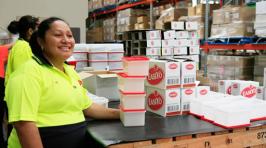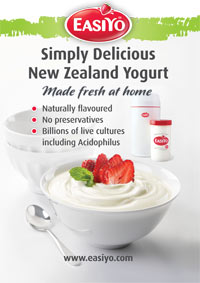Production process

Iva in the factory.
The new production plant was designed to provide more space and facilitate growth. At 700m², the factory has three times more room than the previous building and two production lines instead of one. The first year of operating two lines, with an improved layout of the production, packaging and labelling operations and new, more efficient machinery, resulted in not just double the production but a rise of over 300%. And there is room for more growth, as at this rate EasiYo is still only producing at one third capability.
Food safety – an essential aspect of the production process in manufacturing food products – is crucial for a company whose selling point is the health benefits of its products and the quality of the ingredients. Every stage of the production process involves complying with food safety standards, and begins before the ingredients reach the factory. Westland Milk Products maintains its own testing regime to ensure that its milk powder complies with requisite food standards as well of those in EasiYo's international markets. Each 25kg bag is assigned a number recording the date and time it was produced – when the powder is delivered to the plant it is scanned and the information is stored in EasiYo's 'traceability information system'. Any product on supermarket shelves can be traced back not only to EasiYo but to the cows that produced the milk for that batch. Companies producing flavouring or colouring also comply with the regulations for EasiYo's international markets
Storage is an important issue at the plant. It is vital that the dried ingredients stay completely dry and that the bacterial culture isn't exposed to any moisture, which would cause it to start growing. The live cultures are stored at 4°c in a special cold store, while the receiving bay (which also contains the packaging store) is kept at 18°c and at a constant level of humidity and pressure.
Critical hygiene area

Simply delicious poster.
Mixing the powder and packaging it into sachets is done in the critical hygiene area – sterile, secure rooms, separated from the rest of the building and with access through one 'red line' room where workers put on their overalls/hats and follow strict hygiene protocols. The mixing room and mixers are cleaned daily – blasted with compressed air and then swabbed with alcohol – and the mixers are also cleaned in between each different-flavoured batch. Blowing compressed air down the machinery, instead of spraying with liquids, ensures that the powder stays dry during all stages of the process.
Yoghurt production starts at the feeder silo, which functions as a large blender. The milk powder is tipped in, followed by the additional ingredients and culture. The mixture is sieved, to remove any remaining lumps and possible foreign material. The workers regularly check the consistency of the powder to ensure it is thoroughly mixed.
The automated packaging process starts with the mixture dropping into the hooper, which tapers in and deposits a set amount into the aluminium foil sachets, filling each one in less than a second. As the culture activates in the presence of both moisture, the package is flushed with an inert gas (nitrogen) to keep its oxygen level as low as possible. A machine controller checks each package to ensure it has sealed correctly and, if there should be any doubt, tests it by submerging it in alcohol – if there are any bubbles it means the package wasn't sealed correctly. As they move down the conveyer belt, the sachets passes over an automatic weighbridge which rejects any that are too light or too heavy.
Samples of each production run – beginning, middle and end – are made up and tested. Each batch must meet specific quality standards for texture, taste and colour, so is checked by staff trained to spot minor changes. Samples are also sent to the laboratory for quality control testing. It can take up to a week to receive the results, so the boxes of sachets are stored in the warehouse with 'hold' stickers on the pallet until given the 'all clear' for distribution. A 'release' sticker in placed on the pallet and the products are ready to be packed either off-line or into containers for delivery.
